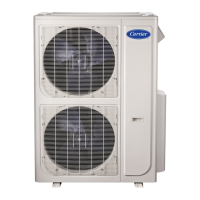
Do you have a question about the Carrier 38MGQF36---3 and is the answer not in the manual?
| Brand | Carrier |
|---|---|
| Model | 38MGQF36---3 |
| Category | Air Conditioner |
| Language | English |
List of essential tools needed for diagnosing unit issues.
General procedures and guidance for troubleshooting unit problems.
Steps for power cycling and initial checks for communication faults.
Procedure to check wiring connections for communication errors.
Checking indoor unit displays for communication status.
Verifying IPM board power and operating LED indicators.
Checking the status of the main board '88' lamp.
Verifying the connection status of the reactor.
Confirming the correct number of indoor units is detected.
Identifying IPM and testing voltage for communication issues.
Diagnosis and solution for IPM to main board communication faults.
Checking signal wires and connections for IPM communication issues.
Guidance on replacing IPM, main board, or control box for E3 errors.
Diagnosis and solution for open/short circuits in temperature sensors.
Checking sensor connections and resistance values.
Diagnosis and solution for voltage protection errors.
Verifying the voltage of the outdoor unit power supply.
Checking voltage between IPM board P and N terminals.
Guidance on replacing rectifiers, IPM, or main board for voltage errors.
Diagnosis and solution for PFC module protection errors.
Checking PFC module connections and IPM P-N voltage.
Checking inductance and replacing PFC module if faulty.
Diagnosis and solution for outdoor fan speed control issues.
Steps to diagnose and resolve outdoor fan speed malfunctions.
Checking fan motor, wiring, and main PCB for speed control issues.
Diagnosis and solution for compressor top temperature protection.
Checking air flow and compressor top temperature.
Checking overload protector wiring and refrigerant charge.
Diagnosis and solution for high pressure protection errors.
Checking high pressure switch wiring and protector.
Checking ambient temp, ventilation, fan, heat exchanger, and refrigerant.
Diagnosis and solution for low pressure protection errors.
Checking low pressure protector wiring and function.
Checking ambient temp, valve core, fan, and refrigerant.
Diagnosis and solution for compressor current protection.
Checking power supply current and system conditions.












